Fueling Progress with Overpressure: Redefine What's Possible!
Welcome to the world of overpressure, where innovation meets safety and performance! Imagine a force that can drive powerful machinery, propel rockets into space, and protect lives in critical situations. Today, we invite you to explore the immense potential of overpressure and discover how it can revolutionize your industry.
In a rapidly evolving world, industries demand solutions that not only maximize productivity but also prioritize safety. This is where overpressure steps in as a game-changer! From engineering marvels to cutting-edge aerospace technology, overpressure plays a pivotal role in ensuring smooth operations and safeguarding your valuable assets.
Join us on this journey as we unlock the mysteries of overpressure and showcase its extraordinary applications. Learn how overpressure can power pneumatic systems, handle challenging industrial processes, and make exploration into the unknown possible.
At the heart of our success lies a deep understanding of overpressure's nuances and the unparalleled expertise to harness its potential for your benefit. Whether you seek enhanced efficiency, meticulous design, or state-of-the-art safety measures, we are here to make it happen.
Dare to innovate and dream big with overpressure at your side. Our tailored solutions are the keys to unlocking new horizons for your industry. As pioneers in the field, we are committed to shaping a safer and more productive future.
Get ready to be inspired, captivated, and empowered by the power of overpressure. Let us embark on this incredible journey together and take your industry to the next level. Together, we will push boundaries, transcend limitations, and redefine what's possible!
Welcome to the limitless world of overpressure - where safety, ingenuity, and success converge. Let's write the next chapter of your industry's story, powered by the force that moves mountains and drives progress!
Are you ready to experience the extraordinary? Embrace the power of overpressure and elevate your industry to unprecedented heights!

Fig 1. Fluid tubes
Browse our wide selection of Pressure Sensor to find the perfect one for your application.
What does " Overpressure" mean?
"Overpressure" refers to a condition in which pressure levels exceed the standard or expected pressure in a particular environment or system. It is a term commonly used in various fields, including physics, engineering, meteorology, and safety regulations.
In different contexts:
- Physics and Engineering: In engineering and physics, overpressure often refers to a sudden or temporary increase in pressure within a confined space or system. This can happen due to various reasons, such as rapid chemical reactions, explosions, or mechanical failures. Overpressure can have significant consequences on the integrity of structures and equipment.
- Meteorology: In meteorology, overpressure is used to describe a region of higher atmospheric pressure compared to the surrounding areas. It is the opposite of "low pressure" and is often associated with fair weather and clear skies.
- Safety and Industry: In the context of safety and industrial processes, overpressure can be a concern when dealing with pressure vessels, pipelines, or storage tanks. Designing and operating these systems within safe pressure limits is crucial to avoid catastrophic failures.
- Blast Protection: In the context of blast protection and building design, overpressure is the shockwave caused by an explosion. Engineers and architects consider overpressure effects to design structures that can withstand potential blast loads.
In summary, "overpressure" refers to the condition when pressure exceeds the typical or expected level in a system or environment, and it is essential to manage and control such situations to ensure safety and proper functioning.
When does Overpressure happen?
Overpressure can happen in various situations and environments, depending on the context. Some common scenarios where overpressure can occur:
- Explosions and Detonations: Overpressure occurs during explosions and detonations, such as those caused by industrial accidents, chemical reactions, or military operations. The rapid release of energy creates a shockwave that leads to a sudden increase in pressure in the surrounding atmosphere.
- Pressure Vessel Failures: Overpressure can result from the failure of pressure vessels, such as boilers, tanks, or pipelines. When the pressure inside these containers exceeds their design limits, they can rupture or explode, causing overpressure.
- Natural Disasters: Certain natural disasters, such as volcanic eruptions and meteorite impacts, can generate overpressure waves that travel through the air, water, or ground, leading to potential damage and destruction.
- Meteorological Phenomena: In meteorology, overpressure refers to regions of higher atmospheric pressure than the surrounding areas. These high-pressure systems are associated with fair weather conditions.
- Shockwaves: Overpressure is produced by shockwaves generated by supersonic aircraft, rockets, or other high-speed objects moving through the air. These shockwaves can have significant effects on the surrounding environment.
- Industrial Processes: Overpressure can occur in various industrial processes involving gases, liquids, or chemicals. Failure to control or regulate pressure within the system can lead to hazardous situations.
- Explosive Devices: Overpressure is a key consideration in designing and evaluating the effects of explosive devices, such as bombs or improvised explosive devices (IEDs).
- Underground Blasts: Excavations, mining operations, or other activities that involve blasting can create overpressure waves in the surrounding rock and soil.
In all these scenarios, it is crucial to understand and manage overpressure to prevent potential hazards, ensure safety, and protect structures and equipment from damage. Engineers, scientists, and safety experts work to design systems and structures that can withstand or mitigate overpressure effects when necessary.

Fig 2. Overpressure
How can recognizing overpressure happen?
Recognizing that overpressure has occurred depends on the specific context and the nature of the event. Here are some common signs and methods to recognize that overpressure has happened:
- Audible Clues: In many cases, overpressure events, such as explosions or detonations, produce loud and distinct sounds that are well beyond the normal ambient noise levels. These sounds can be a clear indicator that an overpressure event has occurred.
- Physical Damage: Overpressure events can cause significant physical damage to structures, buildings, or surrounding environments. Look for signs of structural damage, shattered glass, or displaced objects as indications of an overpressure event.
- Pressure Gauges and Monitoring Systems: In industrial settings or where pressure systems are in use, pressure gauges and monitoring systems are installed to measure and display the pressure levels. If these devices indicate pressure readings beyond the normal operating range, it may signal an overpressure event.
- Eyewitness Accounts: If there are people present during the event, eyewitness accounts can provide valuable information about what happened and can help determine if an overpressure event occurred.
- Seismic Monitoring: For large explosions or events like volcanic eruptions, seismic monitoring can detect the shockwaves or ground movements associated with overpressure.
- Meteorological Observations: In meteorology, overpressure is associated with high-pressure systems that lead to fair weather conditions. Meteorological data from weather stations and satellites can help identify areas of overpressure.
- Blast Wave Effects: In the case of explosions, overpressure results in a blast wave that travels through the air. The blast wave can cause damage to structures and injury to people at varying distances from the explosion site.
- Casualties and Injuries: Overpressure events can cause injuries or fatalities to people in the vicinity of the event. Medical personnel responding to the incident may notice injuries consistent with the effects of overpressure, such as blast injuries.
- Remote Sensing and Imaging: In some cases, remote sensing technologies, such as satellite imaging or drones, can be used to assess the extent of damage and identify potential overpressure events.
It is important to note that overpressure events can have severe consequences, so if you suspect an overpressure incident has occurred, it is essential to prioritize safety and contact the appropriate authorities or emergency services immediately. Additionally, if you are in an industrial setting or working with pressure systems, it is crucial to follow safety protocols and regularly inspect and maintain pressure equipment to prevent overpressure incidents.
How can measure the overpressure?
Measuring overpressure involves using instruments specifically designed to gauge pressure levels that exceed ambient or standard atmospheric pressure. The choice of measurement device depends on the context and the magnitude of the overpressure you want to measure. Here are some common methods for measuring overpressure:
- Pressure Gauges: Pressure gauges are simple devices used to measure pressure in various applications. For moderate overpressure, standard pressure gauges can provide accurate readings. However, for high overpressure events like explosions, special blast pressure gauges may be required.
- Piezoelectric Sensors: Piezoelectric sensors are sensitive to pressure changes and can be used to measure overpressure. These sensors generate an electrical charge in response to pressure changes, providing data on the magnitude and duration of the overpressure event.
- Strain Gauges: Strain gauges are devices that measure changes in strain or deformation of a material due to pressure. They can be used to indirectly measure overpressure by detecting the strain caused by the pressure wave.
- Blast Pressure Sensors: In cases of explosive events, specialized blast pressure sensors are used to measure the intense and rapid pressure changes associated with the blast wave. These sensors are designed to withstand high-energy impulses.
- Pressure Transducers: Pressure transducers are devices that convert pressure into an electrical signal. They can be used to measure overpressure and are often used in industrial settings and research applications.
- Barometers: In meteorology, overpressure is referred to as high atmospheric pressure. Barometers are instruments used to measure atmospheric pressure, and when the reading is higher than normal, it indicates overpressure.
- Seismometers: Seismometers can detect ground movements caused by overpressure events, such as explosions or volcanic eruptions. These instruments help in assessing the magnitude of the event.
- Airblast Monitors: Airblast monitors are specialized instruments used to measure the pressure of air blasts, particularly in mining, quarrying, or blasting operations.
It is crucial to select the appropriate measuring instrument based on the specific application and the level of overpressure expected. Additionally, when dealing with potentially dangerous overpressure events, safety precautions should always be followed, and accurate measurements can assist in understanding the impact and potential hazards associated with the event.
Overpressure formula
The formula for calculating overpressure depends on the specific situation and the units used to express pressure. In general, overpressure can be calculated as the difference between the actual pressure (P_actual) and the reference pressure (P_ref). The formula can be represented as
Overpressure (ΔP) = P_actual - P_ref
Where:
- ΔP is the overpressure (difference in pressure).
- P_actual is the actual pressure experienced during the event or process.
- P_ref is the reference pressure, typically the ambient pressure or standard atmospheric pressure.
If both pressures are given in the same units (e.g., Pascals, psi, bar), the overpressure will have the same units as well. Keep in mind that overpressure can be positive or negative, depending on whether the actual pressure is higher or lower than the reference pressure.
For example, if the ambient pressure is 1 atmosphere (101,325 Pascals or 14.7 psi), and an explosion generates a peak pressure of 300,000 Pascals (Pa) at a specific location, the overpressure at that location would be:
ΔP = 300,000 Pa - 101,325 Pa = 198,675 Pa (positive overpressure)
It's important to note that overpressure is just one aspect of understanding the impact of an event or process. Other factors like the duration of the overpressure, the distance from the source, and the structural strength of surrounding objects should also be considered when assessing potential damage or safety risks.
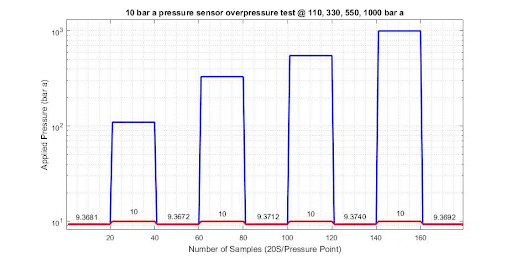
Fig 3. OVERPRESSURE APPLICATION EXAMPLE
What are the overpressure types?
Overpressure can be categorized into different types based on the source or cause of the pressure increase and the way it is generated. Here are some common types of overpressure:
- Mechanical Overpressure: Mechanical overpressure refers to pressure increases caused by mechanical actions, such as the compression of gases or fluids within a confined space. It can result from mechanical processes like pumping, compression, or mechanical failure of pressure-containing components.
- Chemical Overpressure: Chemical overpressure occurs due to chemical reactions that release gases or increase the pressure within a system. It is often associated with reactions involving rapid gas evolution or the release of volatile compounds.
- Explosive Overpressure: Explosive overpressure is a sudden and intense increase in pressure caused by an explosion. It can result from various sources, including industrial accidents, terrorist acts, or military operations.
- Environmental Overpressure: Environmental overpressure refers to pressure changes caused by natural phenomena or environmental factors. Examples include pressure changes due to volcanic eruptions, meteorite impacts, or shockwaves from earthquakes.
- Aerodynamic Overpressure: Aerodynamic overpressure is generated by high-speed objects moving through the air, such as supersonic aircraft or rockets. It creates shockwaves and increased pressure in the surrounding air.
- Blast Overpressure: Blast overpressure specifically refers to the shockwave generated by an explosion. It is a type of overpressure that can cause significant damage to structures and pose a threat to human safety.
- Hydraulic Overpressure: Hydraulic overpressure occurs when excessive pressure is built up in hydraulic systems due to pump failures, valve malfunctions, or blocked lines.
- Pneumatic Overpressure: Pneumatic overpressure is the result of excessive pressure in pneumatic systems due to issues like compressed air leaks or improper pressure regulation.
- Overfill Overpressure: Overfill overpressure can occur in storage tanks or vessels when they are filled beyond their capacity, leading to increased pressure and potential failures.
- Overpressure Due to External Forces: Overpressure can also be generated by external forces acting on a pressure-containing system, such as thermal expansion or pressure transients caused by sudden valve closure or pump shutdown.
Each type of overpressure poses unique challenges and requires specific measures for detection, monitoring, and safety management. Understanding the source and nature of overpressure is crucial for implementing appropriate safety measures and ensuring the integrity of pressure systems and equipment.
Compare all the types in a table
Below is a table comparing the different types of overpressure based on their sources and characteristics:
| Type of Overpressure | Source/Cause | Characteristics |
| Mechanical Overpressure | Mechanical actions, compression | Result of mechanical processes like pumping or mechanical failure |
| Chemical Overpressure | Chemical reactions | Caused by rapid gas evolution or release of volatile compounds |
| Explosive Overpressure | Explosions | Sudden and intense increase in pressure due to an explosion |
| Environmental Overpressure | Natural phenomena or environment | Pressure changes due to volcanic eruptions, meteorite impacts, etc. |
| Aerodynamic Overpressure | High-speed objects moving through air | Generated by supersonic aircraft, rockets, and other high-speed objects |
| Blast Overpressure | Explosions | Shockwave generated by an explosion, causing damage to structures |
| Hydraulic Overpressure | Hydraulic system issues | Excessive pressure due to pump failures, valve malfunctions, etc. |
| Pneumatic Overpressure | Pneumatic system issues | Excessive pressure in pneumatic systems due to leaks or regulation issues |
| Overfill Overpressure | Overfilling of tanks or vessels | Occurs when tanks or vessels are filled beyond their capacity |
| Overpressure Due to External Forces | External forces acting on system | Pressure changes due to thermal expansion, sudden valve closure, etc. |
It's important to note that these types of overpressure can occur in various industrial and natural scenarios, and understanding their specific characteristics is crucial for implementing appropriate safety measures and ensuring the integrity of pressure systems and equipment.
is overpressure useful in the industry?
Yes, overpressure is a concept that is useful and important in various industries. Proper understanding and management of overpressure can significantly enhance safety, efficiency, and the overall performance of industrial processes. Here are some ways overpressure is utilized in different industries:
- Safety and Process Control: In industrial settings that deal with pressurized systems, such as chemical plants, refineries, and power plants, understanding overpressure is crucial for maintaining safe operating conditions. Pressure relief systems, such as safety valves and rupture disks, are designed to protect equipment and personnel from overpressure events by releasing excess pressure before it becomes hazardous.
- Design and Engineering: Engineers and designers consider overpressure when developing pressure vessels, pipelines, and other structures to ensure they can withstand potential pressure surges or explosions. Properly designed and tested equipment is essential for preventing catastrophic failures caused by overpressure.
- Mining and Quarrying: In mining and quarrying operations, controlled blasting is used to break rock and extract minerals. Understanding overpressure is crucial to mitigate the potential impact of blasts on surrounding structures and communities.
- Aerospace and Aviation: Overpressure is a critical consideration in the design and testing of aircraft and spacecraft. Supersonic flight and rocket launches generate shockwaves that can impose overpressure on the vehicles and surrounding structures.
- Automotive Safety: In automotive safety systems, overpressure can be used to trigger airbags in the event of a collision. Crash sensors detect rapid deceleration, and the overpressure generated by gas generators inflates the airbags to protect occupants.
- Industrial Cleaning: In industrial cleaning processes, such as high-pressure water jetting or sandblasting, overpressure is used to remove dirt, debris, and coatings from surfaces.
- Pneumatic Systems: In various industries, overpressure is used in pneumatic systems to power machinery and operate tools.
- Research and Testing: Overpressure is also employed in research and testing applications, such as calibrating pressure instruments, testing material strength, and studying the effects of shockwaves on structures.
While overpressure can pose risks in certain situations, its proper understanding and management contribute to improved safety, efficiency, and the successful operation of many industrial processes. Ensuring the safe handling and control of overpressure is of utmost importance to prevent accidents and protect personnel, equipment, and the environment.
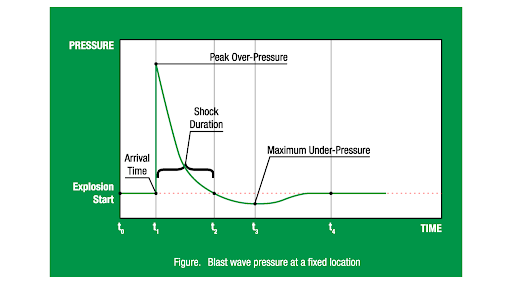
Fig 4. The variation in pressure over time for a typical blast wave from a fixed explosion is simplified.
Where can use the overpressure?
Overpressure can be used in various practical applications across different industries. Here are some common areas where overpressure is utilized
- Cleaning and Surface Preparation: High-pressure water jetting and sandblasting are examples of techniques that use overpressure to clean surfaces, and remove paint, rust, or coatings from various materials.
- Material Forming and Shaping: In certain manufacturing processes, overpressure is applied to shape materials or form products, such as in blow molding or pressure casting.
- Pneumatic Systems: Overpressure is used in pneumatic systems to power pneumatic tools, operate actuators, and drive machinery in industrial settings.
- Industrial Fluid Transport: Overpressure is used to move fluids through pipelines and transport them to different parts of industrial processes.
- Mechanical Systems: Overpressure is utilized in hydraulic systems to operate machinery and heavy equipment, such as hydraulic presses.
- Explosive Engineering: In controlled blasting for mining, construction, and demolition, overpressure is used to break rock and remove unwanted materials.
- Airbags and Safety Devices: In automotive safety systems, overpressure triggers airbags during a collision to protect vehicle occupants.
- Aerospace and Propulsion: Overpressure is used in aerospace engineering for rocket propulsion, wind tunnel testing, and aircraft aerodynamic research.
- Calibration and Testing: In laboratories and industrial settings, overpressure is used to calibrate pressure instruments and conduct various testing procedures.
- Research and Scientific Studies: In scientific experiments, overpressure can be applied to study the effects of shockwaves and pressure changes on materials and biological samples.
- Meteorology: In meteorological applications, overpressure is used to describe high-pressure systems that bring fair weather conditions.
- Safety and Pressure Relief: Overpressure is crucial in pressure relief systems, safety valves, and rupture disks to protect equipment and personnel from dangerous pressure levels.
It's important to note that while overpressure can be advantageous and beneficial in these applications, it must be managed and controlled appropriately to avoid potential hazards and ensure safe operation. Engineers, scientists, and safety professionals work to design and implement systems that utilize overpressure effectively while prioritizing safety and risk management.
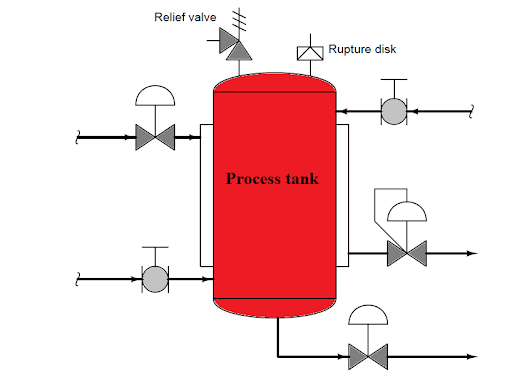
Fig 5. protecting devices from Over Pressure
What is Burst pressure?
Burst pressure, also known as burst strength, is the maximum pressure that a container, vessel, or material can withstand before it experiences a catastrophic failure or rupture. It is a critical parameter used to evaluate the safety and reliability of various pressure-containing components and systems.
In engineering and industrial applications, burst pressure is a vital design consideration for pressure vessels, pipelines, hoses, and other containers that handle fluids or gases under pressure. It is essential to ensure that these components are designed to withstand pressures well above the maximum operating pressure they are expected to encounter during normal use.
Burst pressure is typically specified as a safety margin above the maximum working pressure to account for any unforeseen or transient pressure spikes. The margin helps prevent accidental failures due to fluctuations or transient pressure increases that might occur during operation.
Manufacturers test pressure vessels and other pressure-containing components to determine their burst pressure accurately. These tests involve applying pressure gradually to the component until it fails. The highest pressure reached before the failure occurs is recorded as the burst pressure.
Designers and engineers use the burst pressure data to set safe working pressure limits and ensure that the component can withstand potential pressure surges or overpressure events that might occur during its lifetime. Compliance with burst pressure specifications is essential to guarantee the safety and integrity of pressure-containing systems and prevent hazardous incidents that could result from overpressure failures.
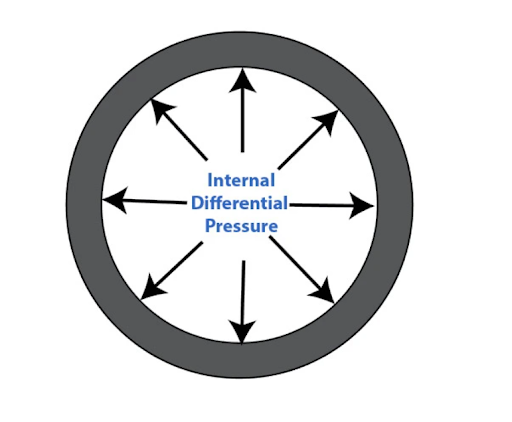
Fig 6. Burst pressure
How can measure the burst pressure?
Measuring the burst pressure of a pressure vessel or any other pressure-containing component involves subjecting it to increasing pressure until it fails or ruptures. However, this process should be done safely, and certain precautions need to be taken to avoid accidents during the testing. Here are the general steps to measure the burst pressure:
- Safety Precautions: Before conducting the burst pressure test, ensure that proper safety measures are in place. Have appropriate safety equipment, a designated test area, and trained personnel to handle the test safely.
- Test Setup: Place the pressure vessel or component in a test rig designed to apply pressure. The test rig should have a pressure source capable of providing gradual and controlled pressure increases.
- Pressure Measurement: Install pressure transducers or gauges at strategic locations on the test specimen to monitor the internal pressure accurately. These instruments will provide real-time pressure readings during the test.
- Controlled Pressure Application: Gradually apply pressure to the test specimen, either manually or using automated control systems. The pressure should be increased slowly to observe the behavior of the component under load.
- Monitor and Record: Continuously monitor the pressure and any physical changes in the test specimen. Record the pressure at the point of failure, which will be the burst pressure.
- Failure Analysis: After the test, perform a failure analysis to understand the mode and location of the rupture. This analysis can provide insights into the component's weaknesses and guide improvements in future designs.
- Safety Relief: In some cases, it's essential to have a safety relief mechanism in place during the test to prevent excessive pressure buildup, especially if the failure mode is rapid and potentially dangerous.
- Compliance with Standards: When conducting burst pressure testing, ensure that it complies with relevant industry standards and codes to guarantee accurate and reliable results.
It is crucial to understand that conducting burst pressure tests requires expertise and should be carried out by qualified personnel with knowledge of pressure vessel testing procedures and safety protocols. Incorrect or unsafe testing methods can lead to hazardous situations, so it is essential to adhere to industry guidelines and best practices during the testing process.
Burst pressure formula
The burst pressure formula depends on the specific geometry and material properties of the pressure vessel or container being tested. In general, the formula for calculating the burst pressure of a cylindrical pressure vessel is derived from the concept of hoop stress, which is the circumferential stress acting around the vessel's wall.
For a thin-walled cylindrical pressure vessel, the burst pressure formula is:
Burst Pressure (P_burst) = 2 * S * t / D
Where:
- P_burst is the burst pressure (maximum pressure the vessel can withstand) in the same units as stress (e.g., Pa, psi).
- S is the tensile strength of the material (ultimate strength) of the pressure vessel in the same units as stress (e.g., Pa, psi).
- t is the thickness of the vessel wall in the same units as the vessel's diameter (e.g., meters, inches).
- D is the diameter of the pressure vessel in the same units as the thickness (e.g., meters, inches).
It's important to note that this formula assumes the pressure vessel is thin-walled, and the hoop stress is the predominant stress component. For more complex geometries or thick-walled vessels, more advanced stress analysis methods may be required to accurately determine the burst pressure.
Additionally, the burst pressure calculation does not take into account factors like material defects, weld quality, or stress concentrations, which can influence the actual burst pressure of the vessel. Therefore, engineers typically apply safety factors and standards specified by codes such as ASME (American Society of Mechanical Engineers) or other relevant industry guidelines to ensure the safe design and operation of pressure vessels.
What is burst pressure used for?
Burst pressure is a critical parameter used for various purposes in different industries. Its primary applications are as follows:
- Design and Engineering: Burst pressure is used during the design phase of pressure vessels, pipelines, and other pressure-containing components. Engineers use burst pressure data to determine the maximum safe operating pressure and ensure the component can withstand pressure levels well above the intended working pressure.
- Safety Verification: Burst pressure testing is an essential step to verify the safety and integrity of pressure vessels and containers. It helps ensure that they will not rupture or fail catastrophically under normal or potential transient pressure conditions.
- Quality Control: Manufacturers use burst pressure testing to ensure that their products meet specified safety and performance standards. This testing is particularly important for critical components used in aerospace, aviation, and other high-risk industries.
- Compliance with Regulations: Burst pressure testing is often a regulatory requirement for certain industries. Companies must demonstrate that their pressure vessels and systems comply with relevant safety standards and codes to obtain certifications and licenses.
- Setting Safe Working Pressure: The burst pressure data allows engineers to establish safe working pressure limits for pressure vessels and containers. It helps determine the operational envelope, ensuring that the pressure is kept within the safe range during regular use.
- Risk Assessment: Burst pressure data is used in risk assessment studies to identify potential hazards associated with pressure-containing systems. This information is crucial for developing risk management strategies and ensuring the safety of personnel and the environment.
- Failure Analysis: If a pressure vessel or container does fail during testing or operation, understanding the burst pressure can aid in failure analysis. Analyzing the mode and location of the rupture can provide insights into the component's weaknesses and guide improvements in future designs.
- Safety Relief Systems: The burst pressure serves as a reference point for setting the pressure relief valves' activation points. These safety devices automatically release excess pressure to prevent overpressure incidents.
- Product Development: Burst pressure data can be used by manufacturers to refine and improve their designs, materials, and manufacturing processes, leading to more reliable and robust products.
Overall, burst pressure plays a crucial role in ensuring the safety, performance, and compliance of pressure-containing components and systems. By using burst pressure data, engineers and manufacturers can design, test, and operate pressure vessels and containers in a manner that minimizes the risk of accidents and maximizes operational efficiency.
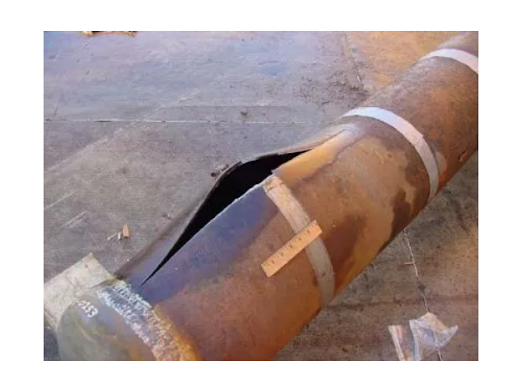
Fig 7. Burst pressure damage
What is the difference between overpressure and burst pressure?
Overpressure and burst pressure are related concepts but have distinct meanings in the context of pressure-containing systems:
Overpressure:
- Overpressure refers to a condition in which pressure levels exceed the standard or expected pressure in a particular environment or system.
- It is a more general term used to describe any situation where pressure exceeds the normal or safe operating pressure of a system.
- Overpressure can be caused by various factors, such as mechanical actions, chemical reactions, environmental events, or external forces.
- Overpressure can be temporary or sustained, and it may or may not lead to catastrophic failure or rupture of the pressure-containing component or system.
Burst Pressure:
- Burst pressure is a specific parameter that represents the maximum pressure that a pressure vessel, container, or material can withstand before experiencing catastrophic failure or rupture.
- It is a critical design consideration for pressure-containing components, such as pressure vessels, pipelines, hoses, and pressure-rated materials.
- The burst pressure indicates the pressure at which a pressure vessel or component will fail due to excessive stress, causing a rupture or burst.
- The burst pressure is a crucial safety limit, and pressure vessels and components are designed to withstand pressures well above their intended working pressures to ensure their integrity and prevent hazardous failures.
In summary, overpressure is a general term used to describe situations where pressure levels exceed the normal or safe operating pressure, whereas burst pressure is a specific parameter representing the maximum pressure at which a pressure vessel or component will fail and rupture. Burst pressure is a critical design consideration to ensure the safety and reliability of pressure-containing components and systems.
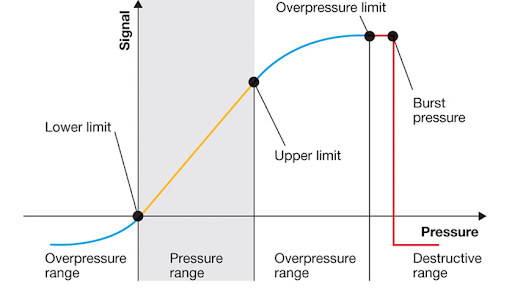
Fig 8. Pressure ranges
What is the relation between burst pressure and overpressure?
The relation between burst pressure and overpressure is that burst pressure is a specific type of overpressure that represents the maximum pressure that a pressure vessel, container, or material can withstand before experiencing catastrophic failure or rupture.
To put it simply:
- Overpressure is a general term used to describe situations where pressure levels exceed the normal or safe operating pressure in a system.
- Burst pressure is a specific instance of overpressure, referring to the critical pressure at which a pressure-containing component or system will fail and rupture.
In engineering and safety considerations, understanding the burst pressure is essential because it indicates the maximum pressure limit a component can handle. Engineers design pressure vessels and other pressure-containing components with a significant safety margin above the expected operating pressure to ensure they do not reach their burst pressure during normal use. The difference between the working pressure and the burst pressure is known as the safety factor, which is a measure of how much extra pressure the component can withstand safely.
In summary, burst pressure is a specific, critical value of overpressure that engineers use to design and ensure the safety and reliability of pressure-containing components and systems. It is one of the primary parameters considered when assessing the integrity of pressure vessels and other pressure-containing equipment.
What is a pressure drop?
Pressure drop, also known as pressure loss, is the decrease in pressure that occurs when a fluid (liquid or gas) flows through a pipe, duct, valve, or any other conduit. It is a common phenomenon in fluid dynamics and is encountered in various industrial, engineering, and everyday applications.
When a fluid moves through a conduit, friction between the fluid and the surface of the conduit causes energy losses, resulting in a decrease in pressure along the flow path. Other factors that contribute to pressure drop include changes in the flow direction, fluid velocity, and the presence of obstacles or restrictions in the flow path.
Pressure drop is crucial to consider in the design and analysis of fluid systems, as it directly impacts the efficiency of the system and the amount of energy required to move the fluid from one point to another. In some cases, the pressure drop is desired, such as in pressure regulators or valves that control the fluid flow by intentionally causing pressure reduction. However, excessive pressure drop can lead to inefficiencies, reduced system performance, and increased energy consumption.
Pressure drop is typically quantified using pressure drop equations or pressure drop charts, which take into account the flow rate, fluid properties, conduit geometry, and other relevant parameters. Engineers and designers use this information to optimize system performance, select appropriate equipment, and ensure the safe and efficient operation of fluid systems.
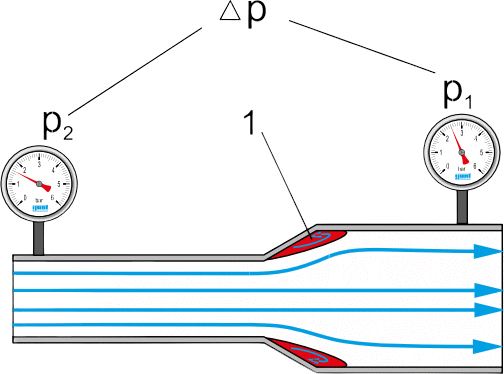
Fig 9. Pressure drop
causes and implications of pressure drop in fluid systems
Causes of Pressure Drop in Fluid Systems:
- Frictional Resistance: As a fluid flows through a conduit, friction between the fluid and the surface of the conduit causes energy losses, leading to pressure drop. The roughness of the conduit's inner surface and the viscosity of the fluid affect the extent of frictional resistance.
- Changes in Flow Direction: Sudden changes in the flow direction, such as bends or elbows in a pipeline, create pressure drop as the fluid changes its momentum and direction.
- Fluid Velocity: Higher fluid velocities in a system can lead to greater pressure drop due to increased frictional losses.
- Obstacles and Restrictions: The presence of obstacles, such as valves, filters, and fittings, or constriction points in the flow path can cause pressure drop as the fluid is forced to pass through these restrictions.
- Pipe Length: Longer pipes result in greater pressure drop due to increased frictional resistance over the length of the pipe.
- Viscosity: High-viscosity fluids experience greater pressure drop as they have higher internal resistance to flow.
Implications of Pressure Drop in Fluid Systems:
- Reduced System Efficiency: Pressure drop results in energy losses, leading to reduced system efficiency. More energy is required to maintain the desired flow rate, impacting the overall performance of the system.
- Reduced Flow Rate: Excessive pressure drop can lead to a significant reduction in flow rate, causing delays in processes or inadequate fluid supply.
- Heat Generation: Pressure drop due to flow restriction can lead to heat generation, which may require additional cooling measures or impact the temperature-sensitive processes.
- Cavitation: In some cases, pressure drop can cause cavitation, where the pressure of the fluid drops below its vapor pressure, leading to the formation of vapor bubbles. When these bubbles collapse, they can cause damage to the conduit and decrease system efficiency.
- Pump and Equipment Overload: High-pressure drops can put additional strain on pumps and equipment, leading to increased wear and tear and potentially reducing their lifespan.
- Inaccurate Measurements: Pressure drop can affect pressure measurements, leading to inaccuracies in flow rate calculations and system monitoring.
Mitigating Pressure Drop:
To mitigate the implications of pressure drop in fluid systems, engineers can employ various strategies:
- Proper Pipe Sizing: Optimize the pipe diameter to reduce frictional losses and pressure drop.
- Smooth Conduit Surfaces: Use smooth inner surfaces in pipelines to minimize frictional resistance.
- Minimize Flow Obstructions: Design systems with fewer valves, fittings, and other flow obstructions to reduce pressure drop.
- Regular Maintenance: Regularly inspect and maintain the system to ensure it operates efficiently and avoids blockages.
- Pressure Drop Calculations: Conduct thorough pressure drop calculations during system design to anticipate potential issues and optimize the system's performance.
By understanding the causes and implications of pressure drop, engineers can design fluid systems that are efficient, reliable, and cost-effective.
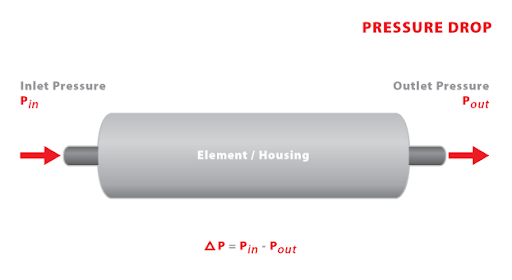
Fig 10. Pressure drop
What is a water hammer?
A water hammer, also known as hydraulic shock, is a sudden and high-pressure surge that occurs in a fluid (commonly water) when its flow is abruptly stopped or redirected. It is a transient phenomenon that can happen in piping systems when there are rapid changes in flow velocity or direction.
When water flows through a pipe, it possesses kinetic energy due to its movement. If the flow is suddenly interrupted, such as by closing a valve quickly or a pump shutting off suddenly, the kinetic energy of the flowing water is converted into pressure energy. This results in a pressure surge that travels backward through the pipe, causing a shock wave.
The shock wave manifests as a loud banging or hammering noise, which is why it is referred to as a "water hammer." This phenomenon can exert significant pressure on the pipe walls and any attached equipment, potentially leading to damage or failure of pipes, valves, fittings, and other components in the system.
The severity of the water hammer depends on various factors, including the flow velocity, pipe length, diameter, and the speed at which the flow is stopped or redirected. Water hammers can be particularly problematic in high-velocity systems, such as those found in industrial and commercial applications.
To mitigate water hammer effects, engineers use various measures, such as installing water hammer arrestors, surge tanks, or air cushions in the piping system. These devices help absorb and dissipate the sudden pressure surges, preventing damage and reducing the noise associated with the water hammer.
Water hammer is a critical consideration in fluid system design and maintenance, as it can have significant consequences for both the system's integrity and the safety of personnel and equipment. By understanding and addressing water hammers, engineers ensure the reliable and safe operation of piping systems.
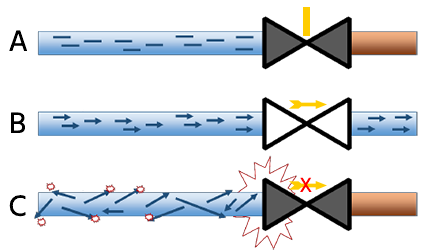
Fig 11. Water hammer effect
Causes and implications of water hammer in fluid systems
Causes of Water Hammer in Fluid Systems:
- Rapid Valve Closure: When a valve in a fluid system is closed quickly, the sudden interruption of flow creates a water hammer. This is a common cause in both industrial and residential systems.
- Pump Shutdown: Rapidly shutting down a pump can cause water hammer as the flow is abruptly stopped, and the kinetic energy of the moving water converts to pressure energy.
- Pump Start-Up: Similarly, when a pump starts up, there can be a surge in flow velocity that leads to a water hammer if not controlled.
- Water Column Separation: If there is a column of water in a pipeline, and a valve or pump is closed at the downstream end, the water column can separate, leading to a water hammer.
- Water Column Compression: A water hammer can also occur when a high-pressure zone moves through a pipe, compressing the water column ahead of it.
Implications of Water Hammer in Fluid Systems:
- Pipe and Equipment Damage: The high-pressure surge caused by water hammer can exert tremendous force on pipe walls and connected equipment, leading to pipe bursts, valve damage, and even equipment failure.
- Noise and Vibration: The water hammer produces loud banging or hammering noises that can be disturbing and cause vibration in the piping system.
- Reduced Equipment Lifespan: Repeated shocks from water hammers can accelerate the wear and tear on pipes and equipment, reducing their lifespan.
- Safety Risks: In extreme cases, water hammers can create dangerous conditions, leading to accidents and injuries if not properly managed.
- Unstable System Operation: A water hammer can cause fluctuations in system pressure, flow rates, and performance, leading to unstable system operation and reduced efficiency.
Mitigating Water Hammer:
To prevent the damaging effects of water hammer, engineers use various strategies:
- Water Hammer Arrestors: Installing water hammer arrestors, also known as surge suppressors, helps absorb and dissipate the pressure surges, reducing the impact of the water hammer.
- Slow Valve Closure: To avoid water hammer, valves can be closed slowly using adjustable closing rates or throttling.
- Surge Tanks and Air Cushions: Surge tanks or air cushions can be added to the system to absorb excess pressure and provide a buffer against water hammer effects.
- Proper Pipe Design: Ensuring proper pipe sizing, minimizing sudden changes in direction, and avoiding excessive flow velocities help prevent water hammer occurrences.
- Pressure Relief Valves: Installing pressure relief valves can provide a safety mechanism to release excess pressure during water hammer events.
By understanding the causes and implications of water hammers, engineers can take appropriate measures to protect fluid systems from damage, enhance safety, and ensure efficient operation. Proper design, maintenance, and the use of water hammer mitigation techniques are essential for a reliable and long-lasting fluid system.
What is the relation between overpressure, burst pressure, pressure drop, and water hammer
Overpressure, burst pressure, pressure drop, and water hammer are all related concepts in the context of fluid systems and pressure-containing components. Here's how they are connected:
Overpressure and Burst Pressure:
- Overpressure refers to a situation where pressure levels exceed the standard or safe operating pressure in a system.
- Burst pressure is the maximum pressure that a pressure vessel, container, or material can withstand before experiencing catastrophic failure or rupture.
- The relation between overpressure and burst pressure is that burst pressure represents a specific instance of overpressure - the critical pressure at which a component fails or ruptures.
Pressure Drop and Water Hammer:
- Pressure drop is the decrease in pressure that occurs when a fluid flows through a pipe or conduit due to friction, changes in flow direction, or flow restrictions.
- Water hammer is a sudden and high-pressure surge that occurs in a fluid system when the flow is abruptly stopped or redirected, leading to pressure surges.
- The relation between pressure drop and water hammer is that water hammer can occur due to rapid changes in flow velocity or direction, leading to sudden pressure surges, which may be caused by pressure drop events.
In summary, overpressure and burst pressure are related as burst pressure is a specific instance of overpressure, representing the critical pressure at which a component fails. Pressure drop and water hammer are connected as water hammer is a result of sudden changes in flow velocity or direction, which may occur due to pressure drop events. All these concepts are essential considerations in fluid system design, safety analysis, and maintenance to ensure reliable and efficient operation while safeguarding the integrity of pressure-containing components.
Conclusion
In conclusion, overpressure and burst pressure are both important concepts in the context of pressure-containing systems:
- Overpressure is a general term that describes any situation where pressure levels exceed the standard or safe operating pressure in a system. It can result from various causes, such as mechanical actions, chemical reactions, environmental events, or external forces. Overpressure can be temporary or sustained and may or may not lead to catastrophic failure or rupture of the pressure-containing component or system.
- Burst pressure, on the other hand, is a specific parameter that represents the maximum pressure that a pressure vessel, container, or material can withstand before experiencing catastrophic failure or rupture. Burst pressure is a critical design consideration for pressure-containing components, such as pressure vessels, pipelines, hoses, and pressure-rated materials. Engineers ensure that pressure vessels and components are designed with a significant safety margin above the expected operating pressure to prevent reaching their burst pressure during normal use.
The relation between burst pressure and overpressure is that burst pressure is a specific instance of overpressure. Burst pressure is the critical pressure at which a pressure-containing component or system will fail and rupture. Understanding burst pressure is essential for designing and ensuring the safety and reliability of pressure-containing components and systems.
Both concepts play vital roles in various industries, ensuring the integrity, safety, and performance of pressure systems and equipment. Engineers and safety experts carefully consider overpressure and burst pressure values during the design, testing, and operation of pressure-containing components to prevent accidents and ensure the well-being of personnel and the environment.
To recap
Q: What is overpressure?
A: Overpressure refers to a condition in which pressure levels exceed the standard or expected pressure in a particular environment or system. It can result from various causes, such as explosions, mechanical failures, or rapid chemical reactions.
Q: What is burst pressure?
A: Burst pressure is the maximum pressure that a pressure vessel, container, or material can withstand before experiencing catastrophic failure or rupture. It is a critical design consideration for ensuring the safety and reliability of pressure-containing components.
Q: How is overpressure measured?
A: Overpressure can be measured using pressure gauges, transducers, or sensors designed to read pressure levels beyond the ambient or standard pressure. Different industries use various instruments based on their specific needs and requirements.
Q: What are some applications of overpressure in industries?
A: Overpressure is used in applications such as pneumatic systems, hydraulic machinery, aerospace propulsion, blast protection, and industrial cleaning. It is crucial for safety, efficiency, and controlled operations in these fields.
Q: How is overpressure managed in industrial settings?
A: Overpressure is managed through the use of safety valves, pressure relief systems, and proper design and testing of pressure vessels and equipment. Safety protocols and regular maintenance are also essential for safe operation.
Q: What are the risks associated with overpressure events?
A: Overpressure events can lead to catastrophic failures, explosions, structural damage, injuries, and environmental hazards. Proper management and prevention are essential to mitigate these risks.
Q: What is the difference between overpressure and burst pressure?
A: Overpressure is a general term describing any situation where pressure exceeds the normal operating pressure. Burst pressure is a specific instance of overpressure and represents the maximum pressure that a component can withstand before rupturing.
Q: How is burst pressure testing conducted?
A: Burst pressure testing involves subjecting a pressure vessel or component to gradually increasing pressure until it fails or ruptures. This controlled testing helps determine the component's burst pressure value for safety evaluation.
Q: What safety precautions are taken to manage overpressure risks?
A: Safety precautions include using pressure relief systems, installing safety valves, adhering to industry standards, regular inspections, and training personnel to handle pressure systems safely.
Q: How is burst pressure used in engineering design?
A: Engineers use burst pressure data to set safe working pressure limits, design pressure vessels with safety margins, and ensure that components can handle potential overpressure events without failure.
References
https://esenssys.com/what-is-overpressure-and-how-to-prevent-it/
https://automationforum.co/how-to-protect-devices-from-over-pressure/
https://minearc.com/overpressure-and-chemical-shelters-understanding-blast-ratings/
https://www.nationalboard.org/index.aspx?pageID=164&ID=381
https://oilfieldmania.files.wordpress.com/2016/06/figure-1-burst-pressure-diagram.jpg
https://www.wermac.org/pipes/pressure_drop.html
https://tameson.com/pages/water-hammer
Recent Posts
-
Booster Pump Troubleshooting and Maintenance: How to Fix and Prevent Common Issues
1. Introduction Imagine turning on your faucet only to be greeted with a weak trickle of water when …22nd Apr 2025 -
Energy-Efficient Booster Pumps: Selection and Tips for Maximizing Performance
1. Introduction Imagine never having to deal with fluctuating water pressure, noisy pumps, or skyroc …19th Apr 2025 -
Booster Pumps for Sustainable Water Systems: Irrigation and Rainwater Harvesting Solutions
1. Introduction Water scarcity is no longer a distant threat—it’s a reality affecting millions …16th Apr 2025




